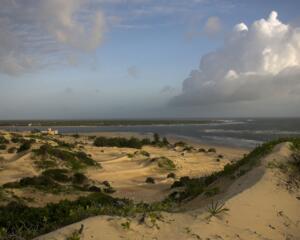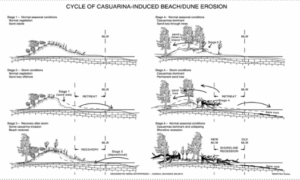Holistic Tree Planting on Amu Sand Dunes
The Amu Dunes stretch 12 km from Shela Village to Kipungani village. They are an important part of the geology of Lamu Island and can’t be missed as you stroll along the beach. They act as a defence system against storms but also more importantly are a filter for freshwater. Below the dunes is Lamu’s only freshwater aquifer. It is for this reason that it is of the utmost importance that the community come together to protect this vital resource in a way that is fair, equitable and appropriate for all relevant stakeholders and the environment.
While the dunes have been protected by the Water Resource Authority under the Amu Sand Dunes Groundwater Conservation Order in 2021, there is little policing of this area, and the area is becoming further depleted as the desire for more land grows.
To protect this resource for generations to come, it is important that we follow best practices to regenerate this resource in a sympathetic way that protects and regenerates biodiversity while protecting and increasing the amount of water in the aquifer.

Problem Statement
Well vegetated dunes encourage prograding and an annual addition of sand, but it’s important the correct vegetation is planted to protect from soil erosion, increase biodiversity, encourage transpiration and protect the aquifer.
Currently, livestock are left to graze freely on the dunes and communities access the land to use the plants and trees on the dunes as firewood, roofing and tap the palms to create palm wine. All these activities, lead to an ever-increasing number of indigenous trees and plants on these dunes.
Many efforts have been made to increase the cover of trees on the dunes, yet these efforts haven’t always succeeded. While sometimes, multiple species of trees are planted at once, there is little after care or protection from livestock. Many of the indigenous trees on the dunes are especially attractive to livestock, so seedling and shoots are often quickly eaten by cows, goats and donkeys. This often means the only species of trees that survive these mass plantings are casuarina. Casuarinas are hardy, drought resistant and not attractive to livestock. While these characteristics might make casuarina an attractive species to plant in this hostile environment, it can cause more problems than solve.
Casuarina is native to Australia, New Guinea, Southeast Asia and India, meaning they are not native to Lamu or Kenya more generally. They are known to grow rapidly, out-compete and destroy native species, and contribute to soil erosion as their root systems are shallow and spread wide. Due to this root system, they are unable to hold the sand in place and are more likely to fall in storms and lead to more sand being lost than protected where there are plantations of casuarina. The image below illustrates how casuarina plantations cause beach and dune erosion in the long term.

A further issue with casuarina is that they often lead to a loss of biodiversity. This is because the trees form a dense forest after colonizing an area and make it impossible for any other species to grow and survive there, also there is little that can grow beneath them due to the many needles that drop. Below the surviving casuarina trees in Shela Dunes, there are no other seedlings of any species that have been able to grow. This illustrates the problem and shows that we must be conscious to plant trees that encourage biodiversity.
A key concern when it comes to planting casuarina is that they are known for lowering the water table of an area and exhausting the moisture in the soil. In Lamu we must be very aware of this issue as we look to tree planting to protect our aquifer. Furthermore, casuarina is unable significantly contribute to transpiration due to the size of their leaves. Transpiration is a vital part of the water cycle and occurs when plants take up liquid water from the soil and release water vapor into the air from their leaves. The increased water vapor in the atmosphere leads to more clouds being created and more rain to fall. With more rain, we can increase water levels in our aquifer.

It is with this in mind that we want to discourage the continued planting of casuarina. And while it may feel like there are limited alternatives, we want to assure you that there are many options we can take to encourage tree cover in the dunes by taking the lead from the current environment.
Reforesting Best Practice
To ensure that trees that are planted grow, it’s important to follow best practices and where appropriate follow direction of local experts and indigenous knowledge. By doing this we can ensure maximum survival of seedlings.
Below is a brief overview of the best practices of reforestation that we can apply on the Shela and Kipungani dunes:
- Maximise biodiversity by choosing multiple species of trees to plant that also encourage an increase in biodiversity after planting
- Select the right tree species to maximise biodiversity and avoid exotics
- Make sure the chosen species are resilient and adaptable to climate change
- Ensure there is follow-up care including watering and continued monitoring
- Protect seedlings from livestock and other animals while plants are young to encourage growth
- Include communities and relevant stakeholders in all plans
The management plan of the Amu Dunes drawn up by Water Resources Authority, also echoes these practices specifically stating among the prohibited activities that exotic trees must not be planted or indigenous trees cleared.
Conclusion
In conclusion, it is in all our interests to plant more trees on the dunes and continue to protect those that are already there. However, it is important that we focus not only on tree planting but on tree growing too. Furthermore, we must pay close attention to the species of tree planted and consult experts with experience of implementing indigenous tree planting projects on the types of trees that are best planted in certain areas.
For the success of future tree planting efforts and to reach the goal of planting 15 billion trees by 2032, it is very important that we utilise local experts and passionate CSO organisations that have the knowledge and drive to deliver high quality sustainable tree planting projects while also creating
a robust network of CSOs to ensure all tree planting projects are joined up and not working in silos.
We also ask that casuarina are no longer a part of tree planting efforts in the dunes, unless they are planted as a part of a holistic well-managed planting and growing project.
Who We Are
This document was created under a consortium is made up of key stakeholders including; Lamu Environment Foundation, Lamu Tourism Association, Collective Sovereignty, Earth Love LTD, Banana House, Shela Environmental Residents Group and Lamu Conservation Trust. All these organisations care deeply about protecting the environment of Lamu for generations to come.
We have used this document to advocate for a more holistic approach to replanting in the dunes and have received support and ascent from the Water Resources Authority, Kenya Forestry Service and Amu Island Water Resource Users Association. The circulation of this document and knowledge continues as we aim for better protection of the dunes.
Lamu Environment Foundation is always looking to support holistic tree planting efforts, please contact hannah@lamuenvironment.org for further information on how we can support.
Sources
- https://www.bgci.org/news-events/scientists-lay-out-10-golden-rules-for-restoring-forests/
- https://en.m.wikipedia.org/wiki/Casuarina_equisetifolia
- http://www.tsusinvasives.org/home/database/casuarina-equisetifolia
- https://caribbeaninvasives.org/index.php/2013/04/02/1957/
- https://gpm.nasa.gov/education/water-cycle
